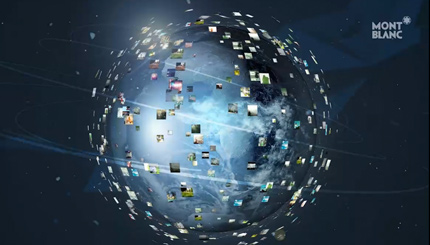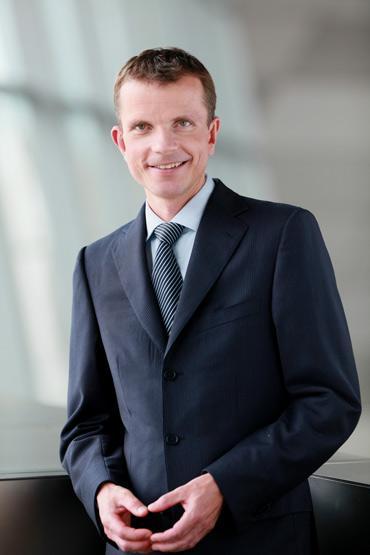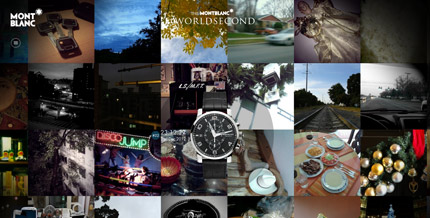WORLDTEMPUS - 29 January 2013
Robin Swithinbank
One of the great things about SIHH is that you have a wealth of great minds from the fine watchmaking industry in one place at one time. For every great watch, there's a brilliant designer, watchmaker, marketer or CEO on hand to share an opinion, reflect on the state of the industry or – if these are people you've known for a while – shoot the breeze. It's that kind of place.
Among those conversations I enjoyed the most was one with the two men charged with propelling Montblanc watches into the future. There's a story unfolding here, and I'm intrigued by it.
Until a few years ago, Montblanc's watch offering was regarded with some circumspection. Fine watchmaking is not the most embracing of communities, and when a brand known for its pens and leather goods rocks up with a collection of pricey timekeepers – as Montblanc first did in 1997 – it has a job on its hands to win people over. That's not a bad thing, by the way – excellence is the barometer in fine watchmaking and if you want to drive in the fast lane, you have to prove yourself. No free rides.
But then Montblanc absorbed Swiss movement specialist Minerva into its set-up and started making some really rather natty stuff. On top of that, they began scouring the world for unheralded but brilliant watchmakers. Products of this horological scouting mission include the Timewriter and Timewriter II, two pieces that will live long in the memory. The latter, a 1/1000th of a second mechanical chronograph dreamed up by young Swiss-Spanish watchmaker Bartomeu Gomila, was launched at SIHH in 2012 and was picked by a number of seasoned industry observers as the standout watch of the fair.
Winning over the world
Anyway, Montblanc, for better or for worse, is here to stay and, I think it's fair to say, is now a force to be reckoned with on the fine watchmaking stage. But even then, it is still in its infancy, not least in taking on the ultimate judge: the consumer.

Tasked with convincing the world to buy Montblanc watches are Alexander Schmiedt, Montblanc's managing director for watches, and Dr. Uwe Ellinghaus, BMW's former marketing guru and now the Hamburg-based brand's executive vice-president for marketing and sales. Schmiedt, unlike Ellinghaus, isn't new to Montblanc, but together they are a new team, and – judging by the half-hour I spent in their company at SIHH – a forward-thinking one.
Top of my list of things to talk to them about was the Montblanc Worldsecond, a web- and app-based communication tool launched in November last year that was designed to cut through the vast swathes of global watch chatter and engage with both new and existing Montblanc customers.
The idea was that smartphone users around the world would take a photo at a preordained second in time using the dedicated Montblanc Worldsecond app downloaded for free to their phones. Between November 1 and December 31 last year there were 60 of these Montblanc Worldseconds, and each simultaneously captured images were uploaded onto a website to create a digital mosaic – a piece of art, according to the brand.
Users registered with either an e-mail address or a Facebook account and were encouraged to share their photos via social media. The incentive was to win one of two watches from the TimeWalker collection – one for the best picture and one for the best gallery of images collated by visitors to the microsite.

Not everyone climbs mountains, right?
By watch industry standards, this kind of campaign is unconventional, to say the least. It demands a lot from users and perhaps because of this, few brands have ventured to engage with the web and social media in this way. What made Montblanc entertain the idea?
“Some, let's say outsiders, wonder why a brand like Montblanc is putting so much emphasis on the digital channel, because many mature, luxurious watchmakers (and also traditional luxury maisons) don't,” acknowledges Ellinghaus, who did not commission the project, but is a fan. “But branding is about differentiation not similarity. And in any case, I think other brands haven't learned the lesson that the future is digital and interactive. Luxury brands are not different to any others in this respect.”
One of the reasons luxury brands have been slow on the digital uptake is, he thinks, because of a misunderstanding regarding who is online and using social media. The default position, he suggests, is to believe that it's old people that buy luxury and that they don't use the Internet.
“But using the Internet and social media is not an age phenomenon,” he counters. “And let's face it, those Digital Natives, who grew up in this environment, were born after 1980 – so they turn 33 this year. I fully believe this is Montblanc's target group, particularly in Asia, where our customers are younger anyway.”
Seven minutes is a long time
Even if it's the right tool, measuring the success of a project like the Worldsecond isn't easy – there's no yardstick because no one's ever done it before (aside from Montblanc's digital campaign in 2011, The Beauty of a Second, which was successful enough to prompt this latest foray). But Schmiedt and Ellinghaus are pleased with the 10,000 global app downloads they received, and with the average of seven minutes spent by each visitor on the microsite.
“Seven minutes is a very long time,” says Ellinghaus. “For engaging people, forget print, where the average view time is two seconds, if at all. At seven minutes long that's almost an in-depth exploration into a brand when you're talking to impatient people.”
The cost, they say, was equivalent to the price of three or four print ads in a leading magazine, or, in Ellinghaus's words, “an amazingly small amount.”
For an industry that's most comfortable with billboards and full-page ads in glossy magazines, this approach is still novel, but to the target audience, it's almost the opposite. The “below-the-line” approach adopted by companies and brands across all sectors is well trodden and proven to work. “You try and do it indirectly, through the backdoor,” says Schmiedt. “Not in an in-your-face way. And even if it doesn't work, you learn – you learn what didn't work.”

Scaling up – long-term gains
Thanks to data capture, the effectiveness of the campaign doesn't end on December 31, 2012, either. “We now also have a way to stay in contact with these people,” says Ellinghaus. “If they registered, we have their details. It [the relationship] lasts longer than the two-month period with those people.”
Against traditional measures, where ads are published in titles with print runs in the hundreds of thousands and even millions, the numbers may seem small, but Montblanc is focusing on engagement not coverage. Those who took part in the Worldsecond have gone deep into the brand and made a connection that's hard to value – at least in immediate terms. There will be quick returns, but as much of the wisdom is in the long-term and in starting customers on a brand journey that will continue for, if the theory works, a lifetime.





